The California Department of Education is asking parents to review its proposed K-12 health curriculum framework, which seeks to radically transform the way public school students think about gender and sexuality. This written set of goals and objectives, revamped in light of the state’s new LGBT affirming sex education law (the Healthy Youth Act), will guide curriculum development over the next decade. Yet children of Christian and other conservative minded parents will find many of the new health lessons in conflict with the values taught at home. (Parents have until Friday, January 11 to submit their comments. See below for details)
“Dispelling myths about gender expectations in kindergarten can lay the groundwork for acceptance, inclusiveness, and an anti-bullying environment in schools,” the proposed framework states. “Gender non-conformity and physical characteristics are often at the root of many forms of bullying.”
Chapter 3: Transitional Kindergarten Through Grade Three
So what are these myths about gender that even kindergarteners must unlearn? Not just the color, toy, and activity preferences the two sexes tend to be attracted to, but “stereotypes” that involve dress and body parts. The framework encourages teachers to read students books like, “My Princess Boy,” about a boy who likes pink dresses and to invite adults, who identify as transgender, to the class as guest speakers.
When it comes to health lessons about body organs, the framework tells teachers to dispel the myth that male and female reproductive organs are different.
The framework states:
When providing instruction on sexual and reproductive organs, teachers can introduce the concept that gender does not always match the sexual and reproductive organs described. For example, teachers may share, “In the classroom, we may use the term ‘female reproductive organs’ but some people who identify as male have these organs. The actual anatomical name for organs is utilized.
Chapter 3: Transitional Kindergarten Through Grade Three
While these new gender lessons start in kindergarten, they are reinforced in every grade. The entire proposed K-12 health curriculum framework, you can read here, consists of nine chapters with several appendixes. It includes 842 mentions of the words “sex,” “sexual,” and “sexuality; 239 mention of “gender,” with “67” in the 4th -6th grad framework alone; and 2 mentions of “abstinence” in the entire 1,000-page health framework.
Although Christian parents would find many objections within this framework, listed below are some of the most objectionable sections.
- The framework recommends a K-3 book on gender identity titled, “Who Are You?”, which introduces kids to the gender spectrum. According to the lesson plan for the book, kids get to work the three layers of “The Gender Wheel” and learn how “grown-ups look at a baby’s body when they are born and make a guess. This is the sex assigned at birth: male or female. (Sometimes people get this confused with gender. But gender is much more than the body you were born with.) ” Chapter 3: Transitional Kindergarten Through Grade Three
- The framework introduces high school kids to the dangers of “spiritual abuse” listed among other types of abuse (emotional, sexual, physical) teens must avoid. Examples of religious abuse include, “Forcing others to adhere to rigid gender roles… . Not allowing a partner to do things they enjoy.” Chapter 6: Grades Nine Through Twelve
- The framework tells middle school teachers to use gender neutral language for romantic relationships and to eliminate words that imply teens have only one sex partner at a time. “In order to be inclusive: the term “partner” should be used in place of or in addition to “boyfriend/girlfriend” or “husband/wife” to avoid assumptions about gender and sexual orientation. Some students may be non-monogamous and the term “partner(s)” may also be used to be more inclusive. Chapter 5: Grades Seven and Eight
- The framework introduces high school students to sexual terms such as polysexual, pansexual, and asexual. Chapter 6: Grades Nine Through Twelve
- The framework encouraged middle school teachers to invite abortion providers as class speakers. “Guest speakers from your local public health department sexual health clinic, or local nonprofit organizations, such as Planned Parenthood, may have well-informed sexual health educators and age-appropriate materials to support comprehensive sexual health education.” Chapter 5: Grades Seven and Eight
Have an Opinion about this Framework?
Make your voice heard before the Friday, January 11, 2019 public comment deadline!
The California Department of Education is collecting public comments on the 2019 Revision of the Health Education Framework. They are asking comments to be placed within the following Word Document:
Public Input Template (DOCX) After downloading the document, fill it out and submit it as a Microsoft Word file (.DOC or .DOCX) and email it to [email protected]. (You can also send general comments about the framework to the same email address.)
Looking for sample health framework comments?
An Orange County team of Informed Parents filled out the “Public Input Template” with a detailed list of suggested changes and additions. Download this suggestion list to help you fill out your input form.
Final adoption of the health education framework by the State Board of Education is scheduled for May 2019.











